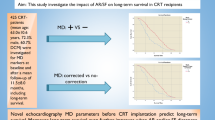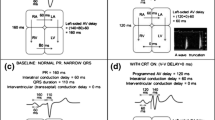Abstract
Setting up a randomized trial to assess the association of mechanical dyssynchrony (MD) and the success of cardiac resynchronization therapy (CRT) in heart failure with a wide QRS complex is ethically challenging. We therefore investigated this association in a retrospective cohort study observing different treatment strategies which were chosen based on the availability of health care resources. The survival of 500 patients from six Western European centers treated with CRT was compared to their 137 Eastern European counterparts not treated with CRT, with regard to the presence of MD. MD was visually assessed and was defined as the presence of apical rocking and/or septal flash. Patients were followed for a mean of 26 ± 8 months for the occurrence of death of any cause. As compared with medical therapy alone, CRT was associated with a more favorable survival (hazard ratio (HR), 0.53; 95% confidence interval (CI) 0.35–0.79; P = 0.002). Patients with MD treated by CRT had better survival than patients belonging to all other groups—they showed 72%, 66% and 56% reduction in all-cause mortality, respectively, compared to patients with MD not treated by CRT (HR 0.28; 95% CI 0.17–0.44), patients without MD treated by CRT (HR 0.34; 95% CI 0.22–0.52) and patients without MD not treated by CRT (HR 0.44; 95% CI 0.25–0.76). Patients with wide QRS complex who are treated with CRT have a significantly better survival when MD is present.



Similar content being viewed by others
References
European Society of Cardiology (ESC), European Heart Rhythm Association (EHRA), Brignole M, Auricchio A, Baron-Esquivias G, Bordachar P, Boriani G, Breithardt OA, Cleland J, Deharo JC, Delgado V, Elliott PM, Gorenek B, Israel CW, Leclercq C, Linde C, Mont L, Padeletti L, Sutton R (2013) ESC guidelines on cardiac pacing and cardiac resynchronization therapy: the task force on cardiac pacing and resynchronization therapy of the European Society of Cardiology (ESC). Developed in collaboration with the European Heart Rhythm Association (EHRA). Eur Heart J. 34(29):2281–2329
Chung ES, Leon AR, Tavazzi L, Sun JP, Nihoyannopoulos P, Merlino J, Abraham WT, Ghio S, Leclercq C, Bax JJ, Yu CM, Gorcsan J, St John Sutton M, De Sutter J, Murillo J (2008) Results of the predictors of response to CRT (PROSPECT) trial. Circulation 117:2608–2616
Beshai JF, Grimm RA, Nagueh SF, Baker JH II, Beau SL, Greenberg SM, Pires LA, Tchou PJ (2007) Cardiac-resynchronization therapy in heart failure with narrow QRS complexes. N Engl J Med. 357(24):2461–2471
Ruschitzka F, Abraham WT, Singh JP, Bax JJ, Borer JS, Brugada J, Dickstein K, Ford I, Gorcsan J III, Gras D, Krum H, Sogaard P, Holzmeister J (2013) Cardiac-resynchronization therapy in heart failure with a narrow QRS complex. N Engl J Med 369(15):1395–1405
Stankovic I, Prinz C, Ciarka A, Daraban AM, Kotrc M, Aarones M, Szulik M, Winter S, Belmans A, Neskovic AN, Kukulski T, Aakhus S, Willems R, Fehske W, Penicka M, Faber L, Voigt JU (2016) Relationship of visually assessed apical rocking and septal flash to response and long-term survival following cardiac resynchronization therapy (PREDICT-CRT). Eur Heart J Cardiovasc Imaging 17(3):262–269
Raatikainen MJP, Arnar DO, Merkely B, Nielsen JC, Hindricks G, Heidbuchel H, Camm J (2017) A decade of information on the use of cardiac implantable electronic devices and interventional electrophysiological procedures in the European Society of Cardiology countries: 2017 Report from the European Heart Rhythm Association. Europace. 19:ii1–ii90
Stankovic I, Janicijevic A, Dimic A, Stefanovic M, Vidakovic R, Putnikovic B, Neskovic AN (2018) Mechanical dispersion is associated with poor outcome in heart failure with a severely depressed left ventricular function and bundle branch blocks. Ann Med 50(2):128–138
Parsai C, Bijnens B, Sutherland GR, Baltabaeva A, Claus P, Marciniak M, Paul V, Scheffer M, Donal E, Derumeaux G, Anderson L (2009) Toward understanding response to cardiac resynchronization therapy: left ventricular dyssynchrony is only one of multiple mechanisms. Eur Heart J 30(8):940–949
Szulik M, Tillekaerts M, Vangeel V, Ganame J, Willems R, Lenarczyk R, Rademakers F, Kalarus Z, Kukulski T, Voigt JU (2010) Assessment of apical rocking: a new, integrative approach for selection of candidates for cardiac resynchronization therapy. Eur J Echocardiogr 11:863–869
Cleland JG, Daubert JC, Erdmann E, Freemantle N, Gras D, Kappenberger L, Tavazzi L, Cardiac Resynchronization-Heart Failure (CARE-HF) Study Investigators (2005) The effect of cardiac resynchronization on morbidity and mortality in heart failure. N Engl J Med. 352(15):1539–1549
Tayal B, Gorcsan J 3rd, Bax JJ, Risum N, Olsen NT, Singh JP, Abraham WT, Borer JS, Dickstein K, Gras D, Krum H, Brugada J, Robertson M, Ford I, Holzmeister J, Ruschitzka F, Sogaard P (2018) Cardiac resynchronization therapy in patients with heart failure and narrow QRS complexes. J Am Coll Cardiol 71(12):1325–1333
Auger D, Bleeker GB, Bertini M, Ewe SH, van Bommel RJ, Witkowski TG, Ng AC, van Erven L, Schalij MJ, Bax JJ, Delgado V (2012) Effect of cardiac resynchronization therapy in patients without left intraventricular dyssynchrony. Eur Heart J 33(7):913–920
Voigt JU, Schneider TM, Korder S, Szulik M, Gurel E, Daniel WG, Rademakers F, Flachskampf FA (2009) Apical transverse motion as surrogate parameter to determine regional left ventricular function inhomogeneities: a new, integrative approach to left ventricular asynchrony assessment. Eur Heart J 30:959–968
Risum N, Williams ES, Khouri MG, Jackson KP, Olsen NT, Jons C, Storm KS, Velazquez EJ, Kisslo J, Bruun NE, Sogaard P (2013) Mechanical dyssynchrony evaluated by tissue Doppler cross-correlation analysis is associated with long-term survival in patients after cardiac resynchronization therapy. Eur Heart J 34(1):48–56
Bacharova L, Mateasik A, Krause R, Prinzen FW, Auricchio A, Potse M (2011) The effect of reduced intercellular coupling on electrocardiographic signs of left ventricular hypertrophy. J Electrocardiol 44(5):571–576
Risum N, Tayal B, Hansen TF, Bruun NE, Jensen MT, Lauridsen TK, Saba S, Kisslo J, Gorcsan J 3rd, Sogaard P (2015) Identification of typical left bundle branch block contraction by strain echocardiography is additive to electrocardiography in prediction of long-term outcome after cardiac resynchronization therapy. J Am Coll Cardiol 66(6):631–641
Steelant B, Stankovic I, Roijakkers I, Aarones M, Bogaert J, Desmet W, Aakhus S, Voigt JU (2016) The impact of infarct location and extent on LV motion patterns: implications for dyssynchrony assessment. JACC Cardiovasc Imaging 9(6):655–664
Stankovic I, Belmans A, Prinz C, Ciarka A, Maria Daraban A, Kotrc M, Aarones M, Szulik M, Winter S, Neskovic AN, Kukulski T, Aakhus S, Willems R, Fehske W, Penicka M, Faber L, Voigt JU (2017) The association of volumetric response and long-term survival after cardiac resynchronization therapy. Eur Heart J Cardiovasc Imaging 18(10):1109–1117
Aalen JM, Remme EW, Larsen CK, Andersen OS, Krogh M, Duchenne J, Hopp E, Ross S, Beela AS, Kongsgaard E, Bergsland J, Odland HH, Skulstad H, Opdahl A, Voigt JU, Smiseth OA (2019) Mechanism of abnormal septal motion in left bundle branch block: role of left ventricular wall interactions and myocardial scar. JACC Cardiovasc Imaging 12(12):2402–2413
Risum N, Jons C, Olsen NT, Fritz-Hansen T, Bruun NE, Hojgaard MV, Valeur N, Kronborg MB, Kisslo J, Sogaard P (2012) Simple regional strain pattern analysis to predict response to cardiac resynchronization therapy: rationale, initial results, and advantages. Am Heart J 163:697–704
Ghani A, Delnoy PP, Ottervanger JP, Ramdat Misier AR, Smit JJ, Adiyaman A, Elvan A (2016) Association of apical rocking with long-term major adverse cardiac events in patients undergoing cardiac resynchronization therapy. Eur Heart J Cardiovasc Imaging 17(2):146–153
Vecera J, Penicka M, Eriksen M, Russell K, Bartunek J, Vanderheyden M, Smiseth OA (2016) Wasted septal work in left ventricular dyssynchrony: a novel principle to predict response to cardiac resynchronization therapy. Eur Heart J Cardiovasc Imaging 17(6):624–632
Donal E, Delgado V, Magne J, Bucciarelli-Ducci C, Leclercq C, Cosyns B, Sitges M, Edvardsen T, Sade E, Stankovic I, Agricola E, Galderisi M, Lancellotti P, Hernandez A, Plein S, Muraru D, Schwammenthal E, Hindricks G, Popescu BA, Habib G (2017) Rational and design of EuroCRT: an international observational study on multi-modality imaging and cardiac resynchronization therapy. Eur Heart J Cardiovasc Imaging 18(10):1120–1127
Cunnington C, Kwok CS, Satchithananda DK, Patwala A, Khan MA, Zaidi A, Ahmed FZ, Mamas MA (2015) Cardiacresynchronisation therapy is not associated with a reduction in mortality or heart failure hospitalisation in patients with non-left bundle branch block QRS morphology: meta-analysis of randomised controlled trials. Heart 101(18):1456–1462
Sipahi I, Carrigan TP, Rowland DY, Stambler BS, Fang JC (2011) Impact of QRS duration on clinical event reduction with cardiac resynchronization therapy: meta-analysis of randomized controlled trials. Arch Intern Med 171(16):1454–1462
Acknowledgements
The authors would like to thank Aleksandra Janicijevic, Aleksandra Zivanic and Milica Tanasijevic for their assistance in data collection.
Funding
IS was supported by a research grant from the European Association of Cardiovascular Imaging. AMD was supported by a research grant from the European Heart Failure Association. JUV is supported by a research grant of the University Hospitals Leuven (OT/12/085) and holds a personal research mandate from the Flemish Research Foundation (1832912N). ANN is partially supported by the Grant No. 175099 of the Ministry of Science, Republic of Serbia. RW receives unconditional research funding from Boston Scientific and Medtronic Belgium, and is supported as a clinical researcher by the Fund for Scientific Research Flanders.
Author information
Authors and Affiliations
Corresponding author
Ethics declarations
Conflict of interest
The authors declare no conflict of interest.
Additional information
Publisher's Note
Springer Nature remains neutral with regard to jurisdictional claims in published maps and institutional affiliations.
Electronic supplementary material
Below is the link to the electronic supplementary material.
Apical 4-chamber view showing a premature septal contraction (septal flash) pulling the apex to the septal side during the early systole, followed by the delayed lateral wall contraction during the ejection phase pulling the apex to the lateral side. This septal to lateral apical motion in systole is known as apical rocking. Supplementary file1 (AVI 62 kb)
Parasternal short-axis view showing an early inward-outward septal motion (septal flash) followed by a late contraction of the posterolateral wall of the left ventricle. Supplementary file 2 (AVI 84 kb)
Rights and permissions
About this article
Cite this article
Stankovic, I., Stefanovic, M., Prinz, C. et al. The association of mechanical dyssynchrony and resynchronization therapy with survival in heart failure with a wide QRS complex: a two-world study. Int J Cardiovasc Imaging 36, 1507–1514 (2020). https://doi.org/10.1007/s10554-020-01865-x
Received:
Accepted:
Published:
Issue Date:
DOI: https://doi.org/10.1007/s10554-020-01865-x




